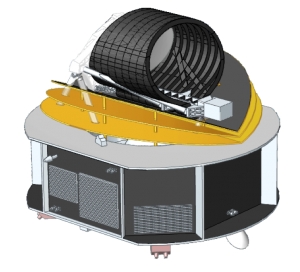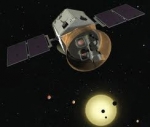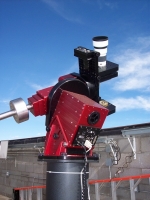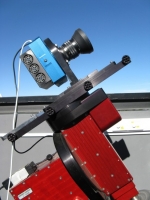Displaying items by tag: exoplanet
Ariel Space Mission
Transiting Exoplanet Survey Satellite (TESS)
The Transiting Exoplanet Survey Satellite (TESS) is a planned space telescope for NASA's Explorer program, designed to search for extrasolar planets using the transit method.
The project is led by the Massachusetts Institute of Technology with seed funding from Google. In 2013 NASA announced that TESS had been selected for launch in 2017. TESS will be located on an High Earth orbit.
Mission concept
Once launched, the telescope would conduct a two-year all-sky survey program for exploring transiting exoplanets around nearby and bright stars. TESS would be equipped with four wide-angle telescopes and charge-coupled device (CCD) detectors, with a total size of 67 megapixels. Science data, which are pixel subarrays around each of up to 10,000 target stars per field, are transmitted to Earth every two weeks for further analysis. Full-frame images with an effective exposure time of two hours are transmitted to the ground as well, enabling astrophysicists to search the data for an unexpected, transient phenomenon, such as the optical counterpart to a gamma-ray burst.
KELT-North telescope
The Kilodegree Extremely Little Telescope (KELT) project of the Ohio State University is an effort to find the best way to discover planetary transits of bright stars and to implement that method by building a telescope and discovering planets.
" In order to learn how to design a survey for transits of bright stars, we start by constructing a model of an all-sky survey for transits. That model points to an optimal survey configuration that uses a small-aperture, wide-field telescope to search for transits of stars in the range 8 < V < 10 magnitude. We used the parameters suggested by the model to build the KELT telescope, and we have deployed it to Winer Observatory in Arizona and begun a long-term survey for planets in a series of fields around the sky. The survey area covers about 25% of the Northern hemisphere and should allow us to detect the most scientifically valuable transiting planets. We examine the performance of the telescope with a number of metrics, and we find that it is performing at the level needed to detect the types of transits we are seeking. We have completed the analysis of the first data set from KELT - a commissioning run from early 2005 that observed the Praesepe open cluster over 74 nights. We obtained light curves of 69,337 stars, and detected 58 long period variables and 153 periodic variables. Sixteen of these are previously known variables, yielding 195 newly discovered variables for which we provide properties and light curves. We also searched for planetary-like transits, finding four transit candidates. Follow-up observations indicate that three of the candidates are astrophysical false positives, with one candidate inconclusively characterized. "
The Ohio State University telescope is also known as KELT-North since a twin project, KELT-South, was setup in South Africa to cover the South part of the sky.
KELT-South telescope
The KELT-South telescope (Kilodegree Extremely Little Telescope - South) is a small robotic telescope that is designed to detect transiting extrasolar planets.
The telescope is owned and operated by Vanderbilt University and is based on the design of KELT-North, which was conceived and designed at the Ohio State University, Department of Astronomy.
The KELT-South telescope serves as a counterpart to its northern twin, surveying the southern sky for transiting planets over the next few years.
Cheops Satellite
CHEOPS (CHaracterising ExOPlanets Satellite) is a planned European space telescope for the study of the formation of extrasolar planets.
Slated for launch in 2017, the mission aims to bring an optical Ritchey–Chrétien telescope with an aperture of 30 cm, mounted on a standard small satellite platform, into a sun-synchronous orbit of about 800 km altitude. For the planned mission duration of 3.5 years, CHEOPS is to examine transiting exoplanets on known bright and nearby host stars. Its main goal will be to accurately measure the radii of the exoplanets for which ground-based spectroscopic surveys have already provided mass estimates. Knowing both the mass and the size of the exoplanets will allow scientists to determine the planets' approximate composition, such as whether they are gaseous or rocky.
DLR Institute of Planetary Research
the Institute of Planetary Research carries out and supports research programs on the internal structure, formation and evolution of the planets, their moons, and asteroids and comets.
Techniques employed include remote sensing and in-situ investigations using instruments carried on spacecraft, astronomical observations from the ground, theoretical modeling, and laboratory experiments.
It is DLR entity.
COROT
COROT (French: COnvection ROtation et Transits planétaires; English: COnvection ROtation and planetary Transits) is a space mission led by the French Space Agency (CNES) in conjunction with the European Space Agency (ESA) and other international partners.
The mission's two objectives are to search for extrasolar planets with short orbital periods, particularly those of large terrestrial size, and to perform asteroseismology by measuringsolar-like oscillations in stars. It was launched at 14:28:00 UTC on 27 December 2006, atop a Soyuz 2.1b carrier rocket, reporting first light on 18 January 2007. Subsequently, the probe started to collect science data on 2 February 2007. COROT is the first spacecraft dedicated to the detection of transiting extrasolar planets, opening the way for more advanced probes such as Kepler and possibly TESS and PLATO. It detected its first extrasolar planet, COROT-1b, in May 2007, just 3 months after the start of the observations. Mission flight operations were originally scheduled to end 2.5 years from launch but operations were extended to 2013.











































